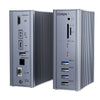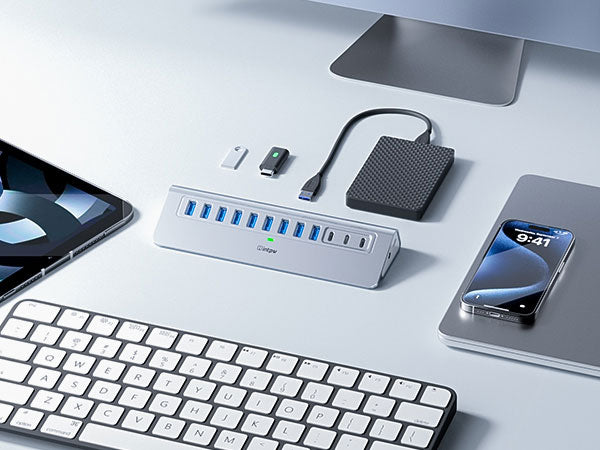
Powered USB Hub vs. Non-Powered USB Hub: Which One Do You Need?
, by USintpw, 5 min reading time

, by USintpw, 5 min reading time
What’s the Difference Between a Powered USB Hub and Other USB Hubs?
Is it worth spending extra on a Powered USB Hub?
To answer this, you first need to understand what a Powered USB Hub is.
What Is a Powered USB Hub?
A powered USB hub is a type of USB hub that comes with its own external power supply. This means that, in addition to drawing power from the host computer, a powered hub has its own AC adapter that supplies extra power to the devices connected to it. This makes powered hubs ideal for powering devices that require more energy than a standard USB port can provide.
Key Features of a Powered USB Hub:
- External power source (AC adapter) to provide consistent and higher power output.
- Can power high-energy devices like external hard drives, printers, and even charging laptops or tablets.
- Offers stable power delivery, making it less likely to experience issues with low power, like device disconnections or slow performance.
What Is a Non-Powered USB Hub?
A non-powered USB hub, also known as a bus-powered hub, draws all its power from the USB port of the host device (like your laptop or desktop). Since these hubs do not have an external power supply, their power output is limited by the host computer's USB port.
Key Features of a Non-Powered USB Hub:
- No external power supply—power is drawn entirely from the host computer.
- Works well for low-power devices such as mice, keyboards, flash drives, and other peripherals that do not require a lot of energy.
- Portable and compact, making them easy to carry around, but limited in their ability to power larger devices.
What Are the Key Differences Between Powered and Non-Powered USB Hubs?
|
Feature |
Powered USB Hub |
Non-Powered USB Hub |
|
Power Source |
External power supply (AC adapter) |
Power drawn from the computer's USB port |
|
Power Capacity |
Can supply more power for energy-hungry devices |
Limited power for low-energy devices only |
|
Device Compatibility |
Can support hard drives, printers, and laptops |
Suitable for keyboards, mice, and USB flash drives |
|
Size |
Typically larger due to the power supply |
Compact and portable |
|
Cost |
Generally more expensive |
More affordable |
How to Determine If You Need a Powered USB Hub
Choosing between a powered and a non-powered USB hub depends largely on the devices you intend to connect and your specific usage requirements. Here are some factors to consider:
A. Type of Devices You’re Connecting
If you're connecting high-power devices like external hard drives, printers, or even charging your laptop, you will need a powered USB hub. These devices require more power than what the computer’s USB port can provide, and a powered hub ensures stable operation without issues like device disconnection.
For example, if you're connecting multiple external hard drives, a powered USB hub ensures they all receive adequate power, allowing for reliable data transfer without speed degradation or interruptions.
B. Number of Devices Connected
If you’re connecting multiple devices at once, a powered USB hub will distribute power more evenly, ensuring that each device gets enough juice to function properly. Non-powered hubs are more suitable for a smaller number of low-power peripherals like USB flash drives, keyboards, or mice, which don’t draw much power.
C. Portability
If you're traveling or need to frequently move your hub between locations, a non-powered USB hub may be a better choice due to its smaller size and lightweight nature. It’s a great solution for basic needs like connecting mice, keyboards, or flash drives to a laptop or desktop without the need for an external power supply.
D. Power Demand
If your devices demand a stable power source for tasks like video editing, gaming, or running multiple high-powered devices, a powered USB hub is the better choice. Devices such as external displays, gaming peripherals, or high-capacity storage need continuous power, and a powered hub delivers that.
When to Choose a Powered USB Hub
Here are some scenarios where a powered USB hub would be the best choice:
- Connecting External Hard Drives: If you frequently transfer large files or work with external hard drives, a powered hub ensures your drives run smoothly without power shortages.
- Running Multiple Devices: When you need to connect several devices at once, like a mouse, keyboard, printer, and external storage, a powered hub will keep everything running without interruptions.
- Laptop Charging: If you need to charge your laptop or tablet while working, a powered hub with USB Power Delivery (PD) can simultaneously charge your device while connecting peripherals.
- Avoiding Power Fluctuations: If your laptop or desktop doesn't have enough USB ports or if its USB ports don’t supply enough power, a powered hub can stabilize the power supply.
Whether you choose a powered or non-powered USB hub depends on the specific needs of your devices and how you plan to use them. Powered hubs offer more versatility, providing ample power for high-demand devices like external hard drives and printers, while non-powered hubs are perfect for lighter tasks.
Understanding the differences and recognizing your needs will help you make an informed decision, ensuring that your devices work seamlessly and efficiently.
If you’re looking for a reliable, high-quality powered USB hub to meet all your device needs, check out the Intpw IF508 Thunderbolt 3 Dock, which offers 16 ports, USB-C PD charging, and more, making it an excellent option for both personal and professional use.

Subscribe to our emails